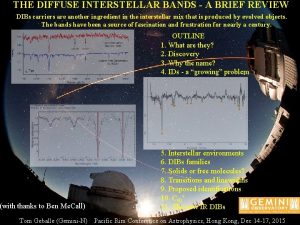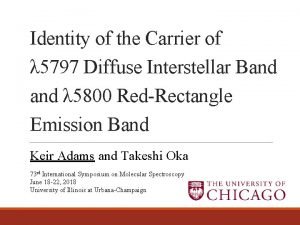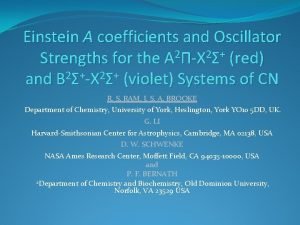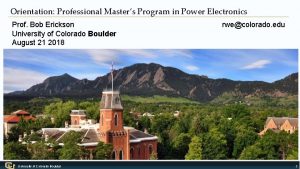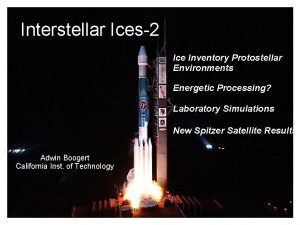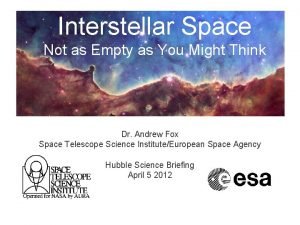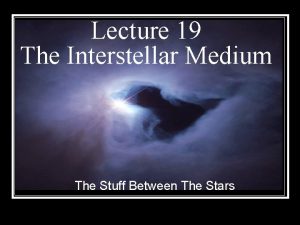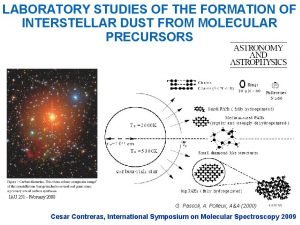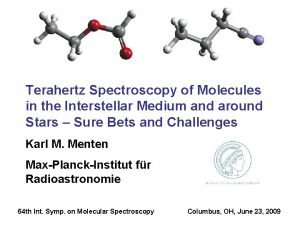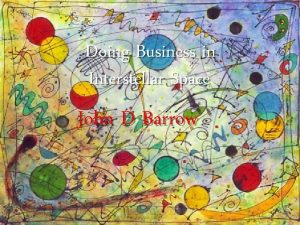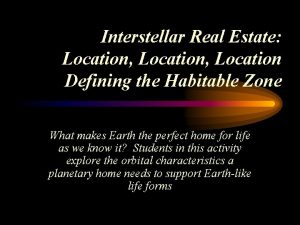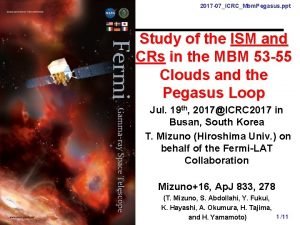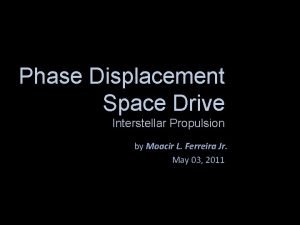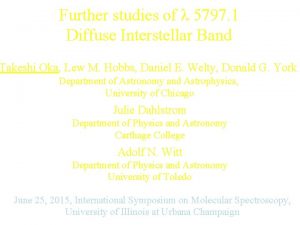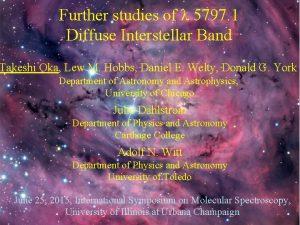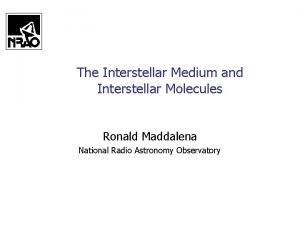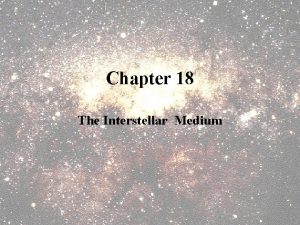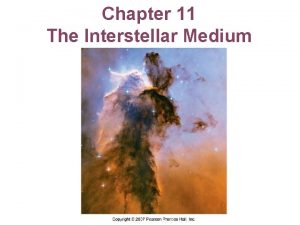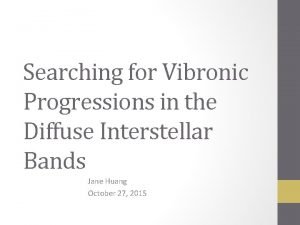Identity of the Carrier of 5797 Diffuse Interstellar















- Slides: 15

Identity of the Carrier of λ 5797 Diffuse Interstellar Band λ 5800 Red-Rectangle Emission Band Keir Adams and Takeshi Oka 73 rd International Symposium on Molecular Spectroscopy June 18 -22, 2018 University of Illinois at Urbana-Champaign

The Diffuse Interstellar Bands: Matching Absorption Bands with Carriers What are the DIBs? • Series of ~500 broad absorption bands observed in the spectra of stars • Originate from gas-phase molecules throughout the interstellar medium • Since their discovery in 1919, only 2 DIBs have been matched with carriers Carbon Chains Fullerenes Polycyclic Aromatic Hydrocarbons (PAHs)

The Red-Rectangle Nebula: DIBs in Emission? ESA/NASA, Hubble

λ 5800 RRB and λ 6615 RRB λ 6613 DIB λ 5800 RRB λ 5797 DIB Van Winckel, H. , Cohen, M. , & Gull, T. R. 2002, A&A, 390, 147

λ 5797 DIB in the Red Rectangle λ 5800 RRB λ 5797 DIB University of Chicago DIB Database

Challenge to DIB-RRB Hypothesis: Non-Convergence of λ 5800 RRB to 5797 Å 6. 6” 2. 5” 10. 0” 14. 7” ESA/NASA, Hubble Sharp, R. G. , Reilly, N. J. , Kable, S. H. , Schmidt, T. W. : 2006, Ap. J, 639, 194

Hypothesis: Foreground-Absorption Red-Shifts the λ 5797 DIB Emission Peaks Objectives: I. To simulate the 5797 DIB emission spectrum, utilizing a polar carbon chain model II. To model the saturation of the blueward 5797 DIB emission by DIB absorbers within the Red Rectangle

Simulating λ 5797 DIB Emission Spectrum λ 5797 DIB Parameters (Huang & Oka, 2015)

Simulating the Extended Tail Toward Red (ETR)

Peak Wavelength Evolution of Simulated Emission 14. 7” 11. 8” 8. 5” 4. 8” 2. 5” ESA/NASA, Hubble

λ 5797 DIB Foreground Absorption

Combining λ 5797 Emission with Foreground Absorption Parameters Transition Dipole: 3 Debye DIB Column Density: Offset 2. 5” 1400 K 300 K 6. 6” 400 K 22 K 14. 3” 70 K 20 K


Conclusions I. λ 5797 DIB and λ 5800 RRB are caused by identical molecular carriers II. λ 5800 RRB’s broadened tail results from HD 44179 radiatively pumping high rotational states (the ETR effect) III. λ 5800 RRB’s non-convergence to 5797 Å is a consequence of self-absorption within the nebula that saturates the lower-wavelength emission

References 1. Huang, J. & Oka, T. 2015, Mol. Phys. 113, 15 2. Oka, T. , Welty, D. E. , Johnson, S. , York, D. G. , Dahlstrom, J. , & Hobbs, L. M. 2013, Ap. J, 773: 42 3. Van Winckel, H. , Cohen, M. , & Gull, T. R. 2002, A&A, 390, 147 4. Sharp, R. G. , Reilly, N. J. , Kable, S. H. , & Schmidt, T. W. 2006, Ap. J, 639: 194 5. Schmidt, G. D. , & Witt, A. N. 1991, Ap. J, 383: 698 6. Witt, A. N. , Vijh, U. P. , Hobbs, L. M. , Aufdenberg, J. P. , Thorburn, J. A. , & York, D. G. 2009, 693: 1946
 Diffuse interstellar bands
Diffuse interstellar bands Diffuse interstellar bands
Diffuse interstellar bands Diffuse interstellar bands
Diffuse interstellar bands Ecen 5797
Ecen 5797 Interstellar
Interstellar Interstellar isabella
Interstellar isabella What is interstellar travel
What is interstellar travel Insterstellar medium
Insterstellar medium Interstellar
Interstellar Interstellar
Interstellar Interstellar time dilation
Interstellar time dilation Interstellar realty
Interstellar realty Interstellar medium ppt
Interstellar medium ppt Interstellar google drive
Interstellar google drive A.backtoschool
A.backtoschool Serous diffuse myocarditis
Serous diffuse myocarditis
